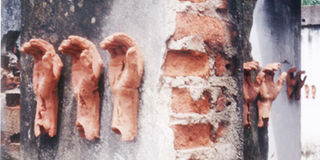Portraying Sri Lanka’s solemn aura with arts

HORRIFIC DEPICTION: Pradeeps’ Broken Hands tell a story of the scars of war, by Pushpa.
What you need to know:
Sri Lanka’s history is intertwined with wars and suffering. For these three artists, only their works will leave a mark and reinforce the need to strive for humanity, David Kaiza writes:-
Pushpa Kumara Koralegedara and Pradeep Chandasiri where both 15 years old when the Sri Lankan war broke out in June 1983 and over the next two decades, watched it deform their country. Pala Pothupitye had only turned 10 the before but like the older two artists, his sense of country and history were deeply marked by the 26-year-war.
Like it did in many former British colonies, the Sri Lankan war erupted through the fault lines of the divide-and-rule policy—along racial, religious and geographical diversity—which served the colonialist in channelling anti-colonial feeling away from the master by setting the ruled against the ruled. When the liberation tigers declared a separatist war in 1983 for the formation of what they called Tamil Eelam, they were reacting to this history. The works of Pushpa, Pradeep and Pala address three key stages in these kinds of war: the ultra nationalism that drives the impulse to war, the dehumanisation that follows and the eventual de-legitimisation of results.
Pala’s courageous maps, his heads of Shiva and chairs; Pradeep’s broken and burnt elements; Pushpa’s collection of ejector, razor-wire and chains in transparent tubing, trace these stages. The three belong to what in Colombo is referred to as the “90s trend”—a hardness forced on art by a war that touched the body and betrayed civilisation.
From civilisation
Sri Lanka has one of the longest unbroken civilisations. Buddhism started in India and gravitated in Sri Lanka for millennia but alongside this had been an older Hindu tradition, later joined by Islam. Latter migrations brought Malays and produced the Burgher people. When the time came, the island’s diversities were pressed into colonial anthropology to state that a more driving, light-skinned “Aryan” race – in Sri Lanka, the Singhala peoples, had enforced civilisation upon the darker-skinned “Dravidians”, who in the country are the Tamil.
Pala is the younger artist but the trajectory of the stages starts with his work. The artist unsparingly points out that racial pride set the island on fire and combined with a first rate, creative mind, he produced a searing pronouncement that leaves little room for extremist equivocation.
Singhala literally means “lion people”, hence the tradition is symbolised by the lion. The Tamil separatists called themselves tigers—a contest of tigers and lions. The message is even more direct in his rendition of southern Sri Lanka on which a well-muscled lion, phallus unsheathed, drives refugees into the Indian Ocean. Pala’s re-definitions set in the unquestionable latitudes and longitudes of the atlas, the sea as blue, land as patches of green and brown, insinuate seamlessly into these.
At first glance, they might be a sea-captain’s or a classroom map, but trust Pala to sidle underneath consciousness to reset the foundation of our imagining the landscape, a new certainty from which we draw further certainties.
It is a direct dig at the racial history that set the island on fire. The war remains a sour point and Pala’s stark images tighten the screws.
When you talk to him, he comes across as understated, a factor owing to his struggle with English. But he knows enough English to say “during the war, I was looking at TV, looking at people enjoy killing. I was depressed.”
His reaction came with immense force, for all his other works, his Head of Shiva, Chair, Ancestor ID, and Dance series are charged indictments served on history and misogyny (hatred of women). He forces us to take him for granted. Because his art presents “things as they are”, he is a naturalist, an iron-clad realist, who, as Theerta manager Lalith Manage says, the artist is “asserting his authority” on what is taken for granted. Where Pala’s work is forceful, Pradeep’s is powerful, and he achieves this by an internal documentation of war.
Scholar, artist and art commentator, Prof Jagath Weerasinghe, says the central motif of Pradeep’s early works was characterised by a “seemingly agonising male figure who presented himself as if he was engaged in a struggle to free himself from traumatic experiences”.
A solemn aura, like a moment of silence, or as he puts it, “the silence after an explosion”, overhangs Pradeep’s installations—his burnt things, the explosion-charred walls, the heap of charcoal, the soot on wood—all evoke a funerary pall and this dirge air ratchets up in his Broken Hands series.
Twelve woodblocks in Broken Hands I each support a plaster-model hand, palm upwards, a light at the base of each. These stand on a spread of charred shards, on a red floor receding into darkness. Broken Hands II was a more stark setting of a white wall covered in soot. He used a bombed-out house for this and his hands crawl upwards throughout the house. It is an eerie image.
When we approach Pradeep’s work, we become aware of horror. This comes of his power to tightly circumscribe the limits of his material and the genius to convey over, in wood, plaster and metal the precise profile of this sense, to impart both form and legitimacy on medium.
This form comes up as organic, for the materials look like they were placed there by a charcoal burner, or a carpenter, not intended as art. What he wants to say – the sense – comes in this effortless format so we might have stopped by something unintended.
But this something has oracular power. The series title, Broken Hands, sounds misleading. A broken hand hangs on to the body. These look severed. But “severed” would be too direct an adjective; the paradoxical “broken” concentrates the mind, a misplaced word, a vehicle beyond form and media. But the hands, the fingers so arranged, the palms having to be nailed to affix to the walls, or so placed on wood as a statue plinth might be, say other things.
These hands strike a universal theme, for hands are central to all religions, the cupped hand, hand as peace offerer, asker for clemency, as healer, as locker of deals; hand as martyr – bearer of stigmata of our sins. The horror that strikes viscerally (you feel a tinge at the wrist) quickly gives way to the sanctimonious.
War and culture
Sri Lanka is a majority Buddhist country and at many street corners in its cities are shrines with the Buddha’s hand gestures and at Catholic shrines, you see the Virgin Mary’s and Christ’s hands. Secularism has deployed the hand in the peace-movement’s V; hand as anti-war signal.
The war Pradeep saw was a violation of the sacred. Pushpa is an artist with a different temperament. He digs upwards, mostly deploying what might be loosely termed as secular motifs to achieve both introspective depth and technical height. If one lined up the three artists, what he does comes at a later stage, from Pala whose maps historicise the narrative, to Pradeep who describes it in motion.
With his Goodwill Hardware, the titling of an exhibition he mounted in 2009, he has rifled through artifacts from a deaf world that presents itself as a sanitised, neat-as-a-filing-cabinet pragmatism; no blood, universal and full of good will. But when the war came to a jolting halt in May 2009 and as so happens when such a shadow dissipates, that same world continues to tag thousands as internally displaced people, anxious to get back to its life.
Pushpa punctures this post war attempt to forget victims. When you look at them from a distance, his installations look more like hospital drip tubes, the transparent plastic tubes running into and out of his board. But inside those tubes, he has inserted razor wires, chains, nails and steel balls used in pipe bombs.
Their inspiration
“Horrific things are being beautified by the media and presented to the public,” he says. He uses the yellow and black stripe barrier tapes to build an inflated tower – “a playful structure so you don’t question what is happening”. He has severally used tenting canvas as background.
He has used saffron-stained wax (saffron a symbol loved by Buddhist extremists) as background to some of his installations. He has used capsules--the sort USAID or the World Health Organisation will aid to people in war zones – to create a bathos-themed installation.
Again, you feel that tightening of the screw. The arts’ collective, Theertha, to which the three belong, has as its members, top Sri Lankan artists who over the past decade have produced intensely original works that have not only addressed the war, but formulated a powerful vocabulary by which to comprehend the psychology of the war years.
It is a collective that moves with the immense originality and courage of its artists. Impulses to war run deep and art that would name this, must speak powerfully. “As a visual artist I am attempting to stimulate thought and discussion through my visual interpretations of our current situation,” Pala says.
Pushpa excoriates the fencing up of people and riles against extremists who say the war is over. “When one part of society was jubilating, another part was in hardship,”
Pradeep ruminates over narcissistic injuries, the meaning of violence that applies to wars wherever and whenever they burn. “I was tortured and my hand disabled for sometime,” he says. “If you cut a hand, it means a person is half-gone.”




